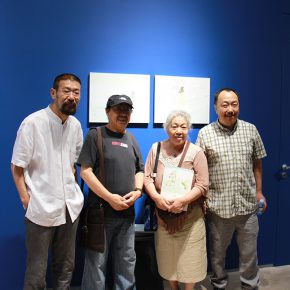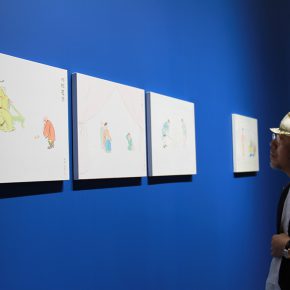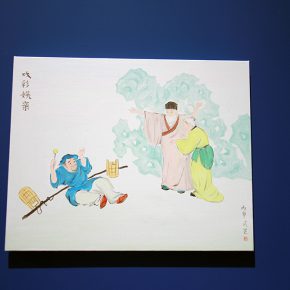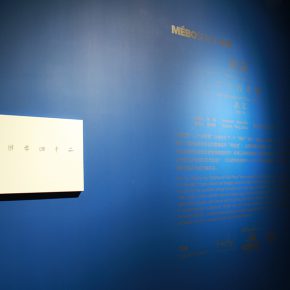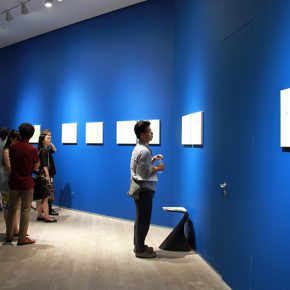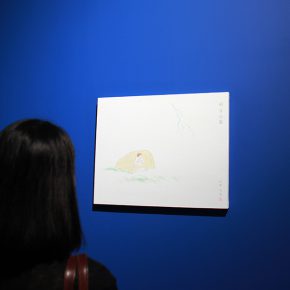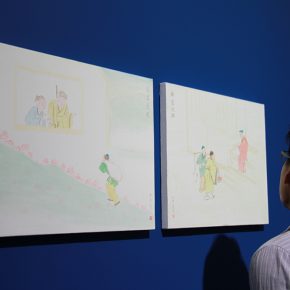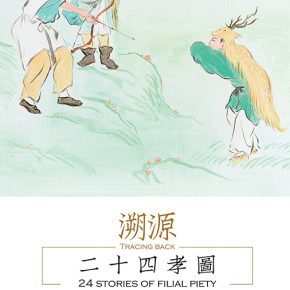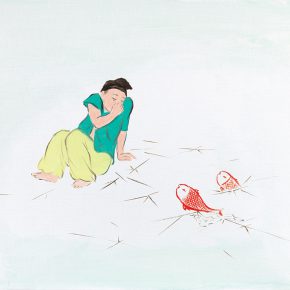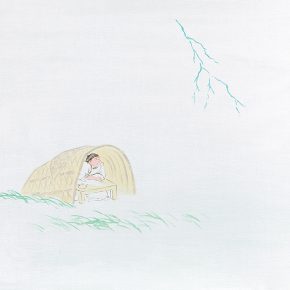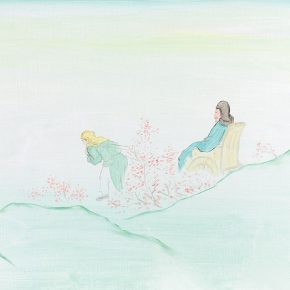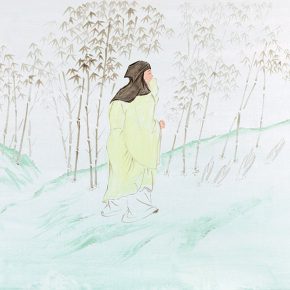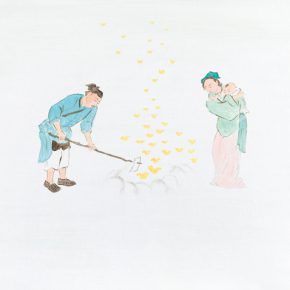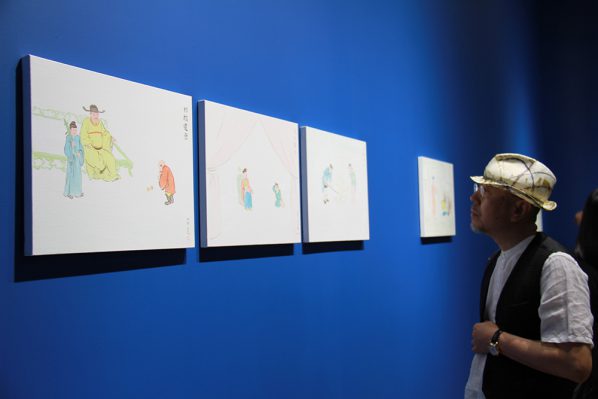
On June 18, 2016 MEBOSPACE opened Wu Yi’s solo exhibition “The origin: Twenty-four filial Exemplar Illustrations” along with his new creation of Twenty-four Exemplar series.
Filial piety is the root of virtue and humanity in Confucius principles which relate to the key concept of family ethics and the foundation of society’s morality. Gentlemen should obtain the qualities of filial piety, which extend to the ideology “ To cultivate the moral self, regulate the family, maintain the state correctly and make peace with everyone. Hence, “Filial piety” is not only restricted in the boundaries of morality but also belongs to political aspects. The beginning of “the Classic of Filial Piety” is illustrated: “ Thus Xiao starts by serving one’s parents, then progresses to serving one’s lord and ends with establishing oneself” this reflects the history of Twenty-four Filial Exemplar Illustrations which contains multiply interpretations, it depends on the context it is involved in. It can be advocating the perception of “Filial piety” and it can be referred to the “popular topic” in the history of painting.
Wu Yi made use of the story “The Twenty-Four Filial Exemplars” originated from the Yuan dynasty authored by Guo Jujing which is also named Twenty-Four Filial Paragons of Exemplar Poetry Anthology. It included twenty four stories from different dynasties to fulfill the concept of filial piety such as “His Filial Piety Moves Heaven and Earth”, “He dressed up to Amuse his parents”, “He fed his parents with Doe’s Milk”, “ He carried rice for his parents”,“ He felt pain in his heart when his mother bit her finger”, “He obeyed his mother and wore thin clothes”, “ He picked mulberries for his mother” and so on. Most of these stories were collected through the scribe of the western Han dynasty Liu Xiang’s work in “Filial Biography” and also depicted certain material in the “search of the supernatural”, “Yi Wen Lei Ju(Classified Excerpts from Ancient Writers)” and “Tai Ping Yu Lan (Imperial Reading of the Taiping)”. During the 20thcentury, Mogao Grottoes have been rediscovered with the carving of Buddhism literally in the time frame of the late Five Dynasties and early Song Dynasty. The discovery of Buddhism literal title is “Ershisi Xiao Yazuowen” in Mogao Grottoes was considered the earliest script regarding the topic of “Twenty-four Filial Exemplar.” Although filial piety is the core value of Confucianism, but the concept of filial piety was diffused with Buddhism and Daoism to interplay and evolve together as time passes. Consequently, the subject matter of Filial Piety was a widely spread theme known for women and children.
The painting of Twenty-Four Filial Exemplars created by Wu Yi was inspired by the handcrafted work from Chen Shaomei. Chen Shaomei’s original manuscript is drawn with traditional Chinese realistic painting. Wu Yi uses oil painting to recreate the work from Chen Shaomei by taking account of the information about the character’s setting and the composition of the picture. Wu Yi uses oil painting to remake the picture with a dramatic approach by withdrawing the characters into an abstract setting.
The painting portrayed one of the stories in the collection of Twenty-Four Filial Exemplars “ He buried His son for His Mother”. The story surrounded with the character Guo Ju with his financial problems in supporting the family. When his wife gave birth to a baby boy, he was afraid it will disrupt the food supply for his mother, therefore he negotiates with his wife to bury his his son. As Guo Ju and his wife were digging up the hole, they found a pile of gold underground. Chen Shaomei presented the picture with the impression of the realistic image such as drawing an actual historical character that existed before within the realistic environment that the character is surrounded in. She added a concrete raiment in clothing with its realistic expression in the characters to display an authentic view. In contrast, Wu Yi removed all the detail background of the tress, rocks and mountain that was originally drawn by Chen Shaomei. Wu Yi placed the characters in a light pluralistic surrounding to diminish the perspective of the scene and the depth of the field to result in a simple two-dimension picture.
The most fascinating alteration was the pile of gold that Wu Yi has changed from Chen Shaomei’s art. Chen Shaomei did not directly express the mythical moment I work. If Chen Shaomei was trying to create a realistic impression then Wu Yi is deliberately destroying the realistic impression by introducing a strong fictitious theme within the characters. It feels like the picture is parading a screen story underneath his behest.
Looking into the choice of subject matter “The Twenty-Four Filial Exemplars” is an extension of Wu Yi’s text trip. Prior to this work, he has accomplished the work of Dwelling in the Funchun Mountains painted by Huang Gongwang, the portrait of Portrait Biography of Sages by Qing Dynasty painter, Dunhuang and other classic paintings combining with his individual style and the transfer replication of other art characteristics. Wu Yi is able to rediscover itself through historical coordination and tries to make a contemporary response. Secondly, in manifesting the picture” The Twenty-Four Filial Exemplar Illustrations” Wu Yi disposed of the historical connotation. It is linked to Wu Yi’s series of “ Xin Ma Po” with the main protagonist positing the identity of guerrillas armed band plus his white head turban. Under Wu Yi’s creation, these characters, such as the men who possess the quality of filial piety and the guerilla armed man does not carry the typical representative image we once remembered in childhood memories through pictures or television. Wu Yi was able to take off the bonded images imposed on these character by eliminating the historical and political factors. These characters are now turning into pure and vivid individuals.
In this sense, we may say Wu Yi’s new creation of “The Twenty-Four Filial Exemplar Illustration” made him stand in an ambiguous position. We may question the way Wu Yi uses the modern formalism “aesthetic attitude” to recreate these classic pictures, nor does he have a sympathetic view on “filial piety” in the ethical and social system construction in ancient China and the exertion of the contemporary China? Or perhaps he did mentality constructing some sort of games with these legendary pictures to investigate an audience’s cultural ethics and their reaction toward his arts? Conceivably, based on the different degree of personal awareness and social experience that individuals had undergone will result in a different form of reflection and perception as they are reviewing these pictures.
The exhibition will continue to August 18.
Courtesy of the artist, photo by Lin Jiabin, translated by Anne Tan and edited by Sue/CAFA ART INFO


